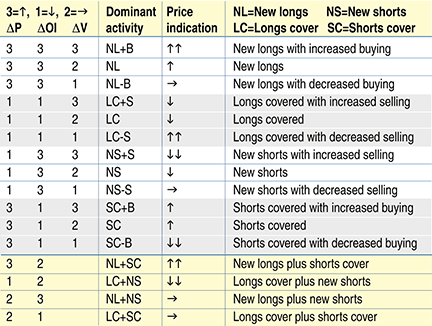FUTURES
The Futures Are Here
Net Effective Market Activity
The desire to learn more about the relationships amid price, volume, and open interest has led to a new concept in evaluating futures contracts. Will it work for you?
Much of the information on futures trading available in the 1980s mentioned the relationship amid price, volume (V), and open interest (OI). Generally speaking, price breakouts from a trading range are more bullish under high volume. Further, an increase in OI with increased price meant that new long position buying must have been the dominant trading activity. Traders have pointed out that if the price increase occurred with a decrease in open interest, then most of the price increase had to be due to short-covering.
To better understand these relationships, refer to the list of meaningful combinations of price, V, and OI changes and the corresponding dominant trading activity in Figure 1.

Figure 1: dominant trading activity vs. daily changes in p, oi, and v. There are 16 changes documented here.
Significance of changes
There were 16 such change sets found. The changes refer to daily changes — that
is, price change today equals close price today minus close price yesterday.
The futures contract with the most volume activity and the highest open
interest is referred to as the lead contract. For consistency, the price
changes and V and OI changes must only be for the lead contract as opposed
to the total V and OI for all open contracts.
(Other studies have stated that the total V and OI for all open contracts should be used instead of the lead contract values. Since many consider this an important issue, further clarification is warranted. See sidebar “Using Lead Contract Values Of Volume And Open Interest” on page 22.)
Figure 1 lists the 16 dominant trading activities for the daily changes in price, OI, and V. For the changes, an increase is denoted by a “3,” a decrease by a “1,” and no significant change by a “2.” Increased or decreased buying is indicated by ±B. Increased or decreased selling is indicated by ±S.
Figure 1 represents a summary of available data. Detailed coverage for several of the items can be found in John J. Murphy’s book Technical Analysis Of The Financial Markets, in which variations of price, V, and OI during top and bottom formations can be found. In addition, George Kleinman, among others, covered the significance of price and OI changes. Donald Iglehart discovered a relationship between the day’s volume magnitude and the number of new positions and closed positions that occurred during the day.